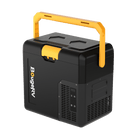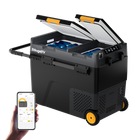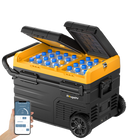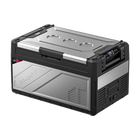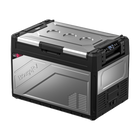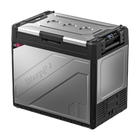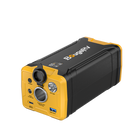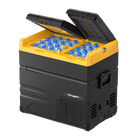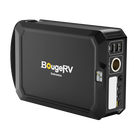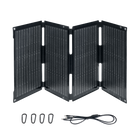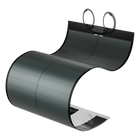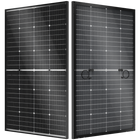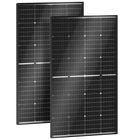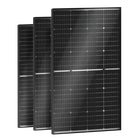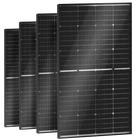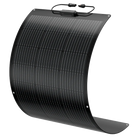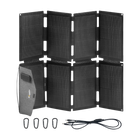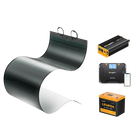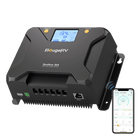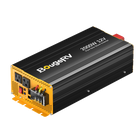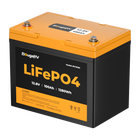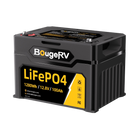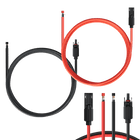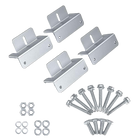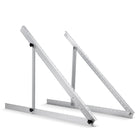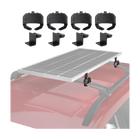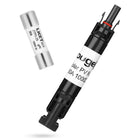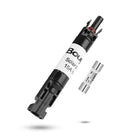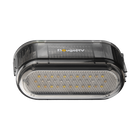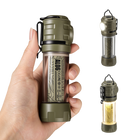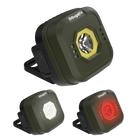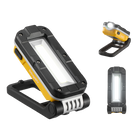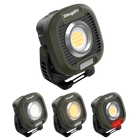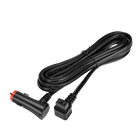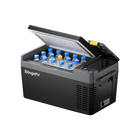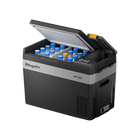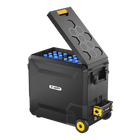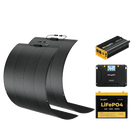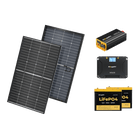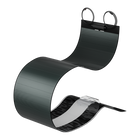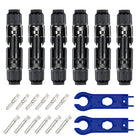MPPT vs PWM Solar Charge Controller


There are two methods for loading a solar charge controller from a solar panel: the MPPT and the PWM Solar Controller. These technologies are both good options when it comes to effectively charging your battery. What needs to be determined when choosing between PWM and MPPT solar charge controllers is which best suits your system.
Go on reading and you will find the differences between MPPT vs PWM solar charge controllers, how MPPT and PWM solar panel work, their pros and cons, etc. Let's dive in!
What Is MPPT vs. PWM Solar Charge Controller?
MPPT (Maximum Power Point Tracking) is a complicated algorithm used in some top-end solar charge controllers. With MPPT technology, MPPT solar charge controller extracts the maximum power from the solar array under all weather conditions or at different times of the day. It can convert excess voltage into amperage, resulting in faster charging times and more efficient usage of your solar panels. But, MPPT solar charge controllers are usually more expensive than PWM controllers.
PWM (Pulse Width Modulation) charge controllers are simpler, and less costly that are suitable for smaller systems. A PWM controller works by connecting directly from the solar array to the battery. When the battery is full, PWM solar charge controller lowers the charging current to prevent overcharging. In this system, the solar array's output voltage is matched with the battery voltage. However, this leads to power loss and less efficiency because the PWM solar charge controller doesn’t transform excess voltage into additional current.
PWM vs. MPPT Solar Charge Controller Comparison Chart
|
PWM Controllers |
MPPT Controllers |
|
PWM solar charge controller is less efficient |
MPPT solar charge controller is more efficient |
|
Cut off excess voltage to charge the battery |
Convert excess input voltage into amperage |
|
Usually operate below the maximum power voltage |
Operate at the maximum power voltage |
|
Appropriate for small solar systems |
Appropriate for large solar systems that have a lower cost per watt |
|
Usually best for hot climates which will not yield as much MPPT boost |
Offer more boost than PWM, especially during cold days or when the battery voltage is low |
|
Cheaper and easier to maintain |
More expensive |
|
It better fits when you have lots of roofs or installing space |
Best for limited roof or mounting spaces as they're more efficient and can harvest the maximum amount of solar energy from a limited space. |
How Does PWM Solar Charge Controller Work?
The PWM controller tracks the battery voltage and decides how much current it can safely feed into it. It works by sending energy pulses to the battery in different lengths. When the battery is nearly full, the pulse length becomes shorter to avoid overcharging. On the other side, when the battery is low on power, the pulses get longer to enhance charging.
The PWM controller is similar to a battery charger in that it regulates the current flowing from the solar panel to the battery to prevent overcharging. When a battery voltage reaches the regulation set point, the PWM algorithm slowly lowers the charging current to avoid heating and gassing of the battery.
The typical advantage of a PWM solar charge controller is to match the solar panel voltage with that of the battery. This ensures prevents battery damage. If you’re using solar energy, it’s a cost-effective solution to invest in a high-quality PWM solar charge controller.

Figure 1: PWM charge controller

Figure 2: Power curve of a PWM Controller
How Does MPPT Solar Charge Controller Work?
An MPPT solar charge controller is a DC-to-DC converter that receives voltage from solar panels and converts it to charge a battery at the most efficient level. It regulates the charge current into the battery like a PWM controller. But, MPPT solar controller converts the voltage coming out of the panel to match what the battery needs. MPPT solar controller consistently tracks and adjusts to the solar panel's optimal voltage output.
Simply put, MPPT solar charge controller looks for the "Maximum Power Point" in the power-voltage curve under varying weather conditions. It then transforms excess voltage into additional current or amperage, leading to higher energy efficiency and faster charging times for your batteries. This adaptability sets it apart from the PWM controller, especially in colder climates or when batteries are in a deep discharge state.
MPPT controllers are more efficient than PWM controllers, generating up to 30% more energy. However, they are more expensive and complex than PWM controllers, as they need more components and circuitry to perform the DC-DC conversion and the power tracking. The MPPT solar controller can also supply power to a DC load, which is connected directly to the battery.

Figure 3: MPPT charge controller

Figure 4: Power curve of a PV panel with load ranges for MPPT controllers.
Differences Between MPPT And PWM Solar Charge Controller
MPPT solar charges are more efficient than PWM solar charge controllers. They transformed excess voltage into amps for charging, resulting in up to 30% more power generation. A system using an MPPT controller can generate more power from the same amount of panels. In comparison, PWM controllers operate at a relatively constant harvesting efficiency despite the solar setup size.
MPPT controllers match the battery resistance to the solar panel, while PWM controllers cut down the panel's voltage to match the required battery voltage.
When it comes to price, MPPT solar charge controllers are more expensive than PWM solar controllers. So, MPPT solar charge controllers are best used for larger solar systems like 400W or more. While PWM solar charge controllers are cost-effective for a small system.
Here, to help you clarify the distinctions between PWM and MPPT solar charge controllers, we list significant 9 differences between them:
1. Initial Cost
MPPT solar charge controller is more expensive than other types of controllers such as PWM, with many popular MPPTs starting at $100, while PWMs pricing for $20-50. This might make it a less attractive choice especially when you’re on a tight budget.
Though MPPT controllers are expensive up front, they are a better investment in the long run because of the enhanced efficiency, flexible design options, and the ability to accommodate the future expansion of your solar array.
2. Efficiency
MPPT controllers are more efficient than PWMS because they adjust their input to harvest the maximum power from the solar panels and then convert this power to supply the varying voltage requirements of the battery plus load. This way, they minimize overall power loss.
3. Ability To Handle Larger Solar Setup Size
MPPT is more efficient for larger systems with massive power needs, as it can take in higher voltage inputs and convert that into a lower voltage-higher current output. So, if you're planning on a more extensive solar setup, MPPT controllers are what you are looking for as they can handle higher power inputs much better than PWM controllers. PWM solar charge cannot handle the high input voltages from these setups.
However, for small solar systems with low voltage, an MPPT solar charge controller might not be the best choice because of its high cost and complexity. While a PWM controller is more suitable for these smaller solar systems as it's cheaper and simpler.
4. Adaptability For Different Weather Conditions
Unlike PWM, MPPT controllers are more adaptable to varying weather conditions. Whether it's a cloudy day or extreme cold, an MPPT controller constantly adjusts to the change in light intensity or temperature, ensuring optimal performance and the highest efficiency at all times.
This is something a PWM controller lacks as its output can greatly diminish during less than ideal weather conditions.
5. Power Generation In Low-Light Conditions
MPPT controller is good at maximizing energy harvest during peak sunlight hours, but its efficiency might reduce in low-light conditions. This factor should be considered if you live in an area with lots of cloudy days or during winter seasons.
In conditions where there's less sunlight such as during cloudy days or winters, PWM controllers are less effective at harvesting power. This results in reduced power generation and lesser overall efficiency.
6. Temperature Dependence
Cold weather can lower solar panel performance. However, MPPT controllers shine in such conditions due to their ability to take advantage of the increased voltage, thereby promoting the system's overall effectiveness.
The performance of PWM controllers is significantly affected by temperature changes. In colder temperatures, the voltage output reduces resulting in decreased charging efficiency.
7. Compatibility With Higher Voltage Solar Panels
MPPT solar charge controller can handle higher voltage inputs. With an MPPT controller, you can use higher voltage panels. This feature can significantly reduce the amount of current needed, thus minimizing cable size and loss of power in the cables.
If your solar energy system has a high voltage output or you are planning to increase the size of your system in the future, an MPPT controller would be a better choice. You can connect multiple panels in series to achieve a higher voltage, which can improve efficiency and allow for longer distances between the solar array and the charge controller.
On the other hand, PWM needs the solar panel voltage to match the battery voltage. If you want to add more panels to your system, you are restricted to using the same voltage panels. This limits the flexibility of expanding your system.
8. Potential Noise Interference
Some MPPT controllers have been reported to produce electrical noise which could interfere with other electronic devices.
9. Installation
Installing an MPPT solar charge controller is more complicated compared to simpler PWM models. It requires professional installation services, which brings additional expenses.
Which Is Better, MPPT or PWM?
When choosing between MPPT charging vs. PWM charging, it really depends on your specific needs like budget, solar setup sizes, and environmental conditions.
MPPT solar charge controllers boost higher efficiency with conversion efficiencies of about 95% for MPPTs, and 75% for PWMs. They convert excess voltage into amperage, thereby reducing overall power loss and enhancing the performance of your solar array.
Therefore, MPPT solar charge controllers are the best choice if you have large solar systems or live in places with fluctuating sunlight. MPPT controllers provide more power in colder temperatures. And they can also be used with less expensive 60-cell modules which are usually unsuitable for PWM controllers.
On the contrary, if you own a small-scale solar project or live in an area with relatively constant sunlight, PWM solar charge controllers save you money while providing enough power. Besides, PWM controllers are less costly than MPPT controllers, therefore, PWM controllers are more economical for small systems.
To sum up, while PWM controllers may have an edge considering cost, MPPT controllers take the lead with their high efficiency, adaptability, and ability to handle larger solar energy systems. Therefore, if maximizing power output and efficient energy use are your primary concerns, an MPPT solar charge controller can be a worthy investment.
However, PWM controllers tend to be a better choice in case you have smaller systems where maximum efficiency is not as crucial, the cost is a significant factor, or in cases where the solar cell temperature is consistently quite high. And before choosing a PWM solar charge controller, carefully consider various factors like size, location, weather conditions, and future expansion plans.
How to Choose The Right Charge Controller?
When choosing the right charge controller for you, there are several factors to consider. These include site conditions, grid size and load, system components, and the cost of your solar power system.
Temperature
For colder conditions, an MPPT controller would be the smarter choice for you. In fact, the more the operating temperature of the solar module decreases, the more the Vmp increases. With the MPPT controller, you can capture the excess voltage from the solar module in order to charge your batteries. This makes the MPPT controller 20-25% more efficient than the PWM controller in colder conditions.
The PWM solar charge controller, on the other hand, would not be able to sense the surge because the battery charges to the same voltage as the pulse width modulation technology. However, when these panels are placed in places where the temperature is warmer, their Vmp decreases and the peak power point operates at a voltage closer to that of a 12V battery. As long as there is no surge to transfer in this case, the utility of the MPPT will become useless. This negates the advantage that MPPT enjoys over PWM.
Grid to load
Relationship between network and load ratio If the solar panel is larger than the energy drawn from the batteries by the load, the batteries will likely stay near a full charge level. In this case, a PWM controller would be able to effectively maintain the system without the added cost of an MPPT controller.
System size
PWM controllers are best suited for small power systems for three reasons. First of all, the PWM controller works with constant harvesting efficiency, regardless of the size of the network. Second, an MPPT controller is less efficient in low power applications. Finally, PWM is less expensive than MPPT controller, making it the more economical choice for customers.
Type of solar module
Independent off-grid solar modules are typically 36 cellular modules that are compatible with both PWM and MPPT technologies. Other grid-connected solar modules available today are not 36-cell modules, making them incompatible with off-grid power systems. An example of this would be a 60 cell 250W panel. This value is too low for a 24 Volt battery, and too high for a 12 Volt battery. With MPPT technology, you can track the MPPT of these less expensive grid tie modules while charging the battery. The PWM regulator does not have this function.
Cost
The MPPT controllers are more expensive than the controllers PWM. However, the advantage of using MPPT is that it is more effective under specific conditions. If you want to buy an MPPT, it is better to first check whether the specialized function of the MPPT can be applied to the site conditions. If you find out that the functions of MPPT are not applicable in your chosen site, it would be more economical for you to choose the PWM controller.
Conclusion
So here’s the thing! You can now clearly tell the difference between the two solar charge controllers, their advantages, and how to choose between them. Before choosing the controller for you, it would be better to consider the locations, the conditions and functions you prefer, and your budget for the technology. Make sure you take the factors presented above into consideration before purchasing your charge controller!
Would like to know more about solar charge controllers? Take a look at BougeRV.com now!
FAQs
1. Is an MPPT controller better than PWM?
MPPT solar charge controllers harvest up to 30% more power from the same number of panels. They also provide more design options and scalability, making them ideal for expanding solar systems.
However, MPPT controllers are more expensive than PWM controllers.
2. Is it worth getting MPPT?
Yes. If have a large solar array, MPPT solar charge controllers are worth to invest as they extract more power and are adaptable to solar panels of high voltage. Here are some advantages of an MPPT solar charge controller:
-
More efficient: MPPT controllers generate up to 30% more power from the same solar panels. And they are more efficient in cloudy and colder conditions
-
Flexible voltage: MPPT systems allow panel voltage to be higher than the battery voltage. They can handle solar arrays with a much higher voltage compared to the battery charging voltage.
-
Battery voltage readings: MPPT readings are more accurate
-
More power production. You can recoup investment costs sooner, especially if you have a grid-tied system.
3. Does an MPPT controller increase amps?
Yes, an MPPT controller can increase the charging current by 25% to 30%. The MPPT controller uses electronic circuitry to regulate the charge voltage to be just above what the battery needs. This allows the controller to trade volts for amps.
4. What size of MPPT do I need for A 1000W solar panel?
To figure out the charge controller size for a 1000W solar panel, you can divide the total watts of the solar array by the voltage of the battery bank. For example, a 1000W solar array with a 24V battery would need a charge controller rated at least 40A. You can also add 25% to allow for cold temperatures and round-up.







